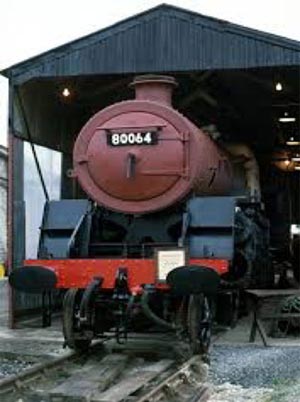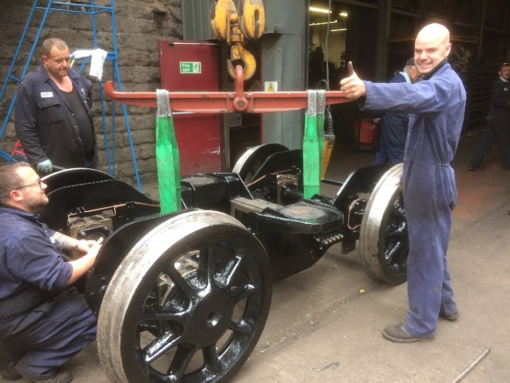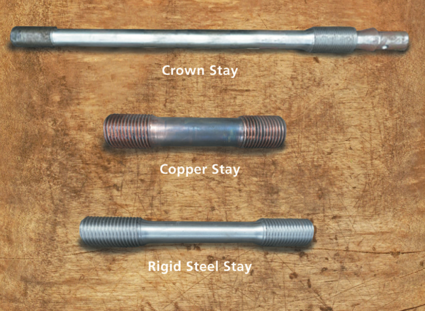
Chairman’s Chat – Number 1 - July 2022
By Neil Taylor
Welcome to the first edition of what I am calling “Chairman’s Chat”. This will be a regular insight into what is going on in the “Non-Engineering” 82045 world. It is affectively the voice of the 82045 Trustees. We felt that with the 82045 build being so well progressed we should provide more information on how we are getting ready to both run the loco and get it to the forefront of Heritage Traction. In just a couple of years we will have to exploit a high point for all of us and with the world moving so fast we will have a relatively small window to make the most of our achievements.
In this edition:
- An introduction from me
- Highlights of the Trustees Meeting (June 2022)
- Getting to the finish line Including – some thoughts from our Treasurer
- Warley Show – Displaying a 3MT at 1:1 scale
Introducing Myself
 Many of you will know me from my days as Engineering Manager for the SVR but most of you will not know anything about my previous life and I thought that it would be worth an introduction to my railway history.
Many of you will know me from my days as Engineering Manager for the SVR but most of you will not know anything about my previous life and I thought that it would be worth an introduction to my railway history.
I might as well go back to the start as this does have some relevance. I was born in Crewe and I guess railways have to be in the blood when that is the case. My maternal grandfather was a welder in Crewe locomotive works and would have worked on many of the great LMS locos. Jim worked on both steam and diesel from the mid-1930s until the early 1970s. My family moved to Liverpool when I was about 5 years old and my first recollections of railways were my regular trips from Liverpool to Crewe. By that time most steam services had gone and I have the rather sad recollection of the condemned lines at Edge Hill and Allerton. Rows of mostly class 5s and 8Fs waiting an inevitable fate. My only certain recollection of working steam was being placed on the footplate of a Black Five on Lime Street station. This would have been towards the end of steam, but it was enough to peak my youthful excitement. In the 1970s we moved again, this time to lovely Devon and a home near to Rattery Bank. The growl of Class 52 Westerns was the norm for my days sat by the disused signal box on South Brent station. It was in Devon that the local “Preserved Line” at Buckfastleigh stimulated an interest in an era that I had pretty much missed. It was here that I started to invest my pocket money in 80064. I would always put something in the box on a visit and little did I know that Standard Tanks would feature significantly later in my life. I have to admit that although the Dart Valley Railway was mostly populated with Swindon’s green and brass collection, I was still more attracted to the perfectly formed standard.
 Leaping forward to the early 1980s and time at the University in Birmingham. I used to call Brignorth station my sanctuary. Nowadays people talk openly about their “Mental Health”. At that time I just knew I had to get away, and where I went was the SVR. I used to love the surprise each time I went, as another piece of history was brought back to life (more of this later).
Leaping forward to the early 1980s and time at the University in Birmingham. I used to call Brignorth station my sanctuary. Nowadays people talk openly about their “Mental Health”. At that time I just knew I had to get away, and where I went was the SVR. I used to love the surprise each time I went, as another piece of history was brought back to life (more of this later).
There is then a big gap in SVR attendance, as my life got serious. I got married, started a family and I had to earn money! I was a very dedicated Engineer and went all over the UK with my jobs. The link with heritage railways was never broken, as each Christmas would see our two children taken to ‘yet another Santa Special’ at many and varied locations. Bridgnorth did still feature but much less often. That is until I was looking for a job in 2016. I wanted to pass my knowledge on to the next generation and I saw the role of “Heritage Skills Academy” leader on the SVR. I thought I just had to go for it. A wise head at the SVR realised that I was actually more qualified for the ‘Works Manager’ role and asked if I would consider applying for that…. the rest is now history.
80064 – My first encounter with BR Standard perfection!
Trustees Meeting
The trustees met in late June and had a very productive meeting over about 4 hours. Whilst much was discussed the biggest impacts would be the conclusion regarding packages for SVR Engineering; the determination of the funds needed to complete the build and the drive for an increase in working members.
I have been in detailed discussions with the SVR since the AGM in April, for the use of SVR Engineering resources to add to our volunteer population. The debate has culminated in the decisions to go ahead with contracting with the SVR to ensure expedient progress towards completion of the build. We will soon be defining packages of work that we wish them to complete, starting after they have completed Hagley Hall. Music to our ears was that we are one of a very limited number of projects that they will be taking on, so there should be little in the way of making progress.
Secondly we had a discussion around the state of our finances. The conclusion was very positive and we can see our way financially to the finish line (more in the next section). We did all agree that we should target further fund raising in the region of £300,000 in order to ensure that we enter the running phase in good health.
Finally much of the discussion was around the locos appearance at the Warley model railway exhibition. This is a once only opportunity to get our project some significant publicity.
We debated the election of officers. I was nominated as Chairman of the Trust, which will technically be Chairman elect, until ratified by the AGM. We also nominated and elected Will Marsh, an Engineering Team Leader on the SVR staff, to become an 82045 trustee. I have known Will for 6 years now and he is a great addition to the team. He is highly skilled and very knowledgeable. Will has done much to learn his craft and understand the workings of steam traction. I have asked Will to take on a special responsibility for the recruitment of the next generation of volunteers for the group. It is becoming clear that we are in a competition for resources alongside many competing interests. We should aim to make the Trust relevant to future populations of enthusiasts. We will have to be ambitious and capture the imagination of some keen youngsters [Note: for the purpose of illustration youngster includes almost anybody under 50].
 In the coming meetings we may elect further trustees and co-opt people onto key committees. Please do not think that we are going to be overly bureaucratic. I see committees as sub-groups of 3 or 4 people with a specific task – Finance, Recruitment, Fundraising, Engineering etc. We agreed that the Trustees will meet formally 4 times a year in March, June, September and December and that the AGM will remain in its April slot.
In the coming meetings we may elect further trustees and co-opt people onto key committees. Please do not think that we are going to be overly bureaucratic. I see committees as sub-groups of 3 or 4 people with a specific task – Finance, Recruitment, Fundraising, Engineering etc. We agreed that the Trustees will meet formally 4 times a year in March, June, September and December and that the AGM will remain in its April slot.
Here's Will Marsh showing his “BR Standard Credentials” – Re-wheeling the 75069 bogie
Getting to the finish line
I mentioned in my personal introduction that one of the great things about the SVR was the real buzz that I used to get when I say a new loco on the railway. It is now such a rare event that we are in the process of something really special. Some of the youngsters on the SVR will not have had that feeling, or witnessed such an event. It is a wonderful coincidence that 4150 and 82045 will be in the Loco Works at Bridgnorth at the same time. It is also quite sobering to think that these might be the last two SVR locos to be brought into existence. I hope that this fact and the fact that 82045 is a genuinely New Build will sustain us all. Please do not let go of this feeling, and realise that when we ask for more money to get to that finishing line we are motivated by emotions on a much higher plane - achievement, pride, camaraderie and self-esteem.
It is no surprise that we are going to have to raise further funds above and beyond those raised to date, if we are to enter the running phase of 82045 in the best of health. However given we have already raised over £1.5m I would suggest that this is absolutely possible. We will need to break things down, so here are some elements of the near term plan:
- Legacies. I understand that this is contentious and you have all heard this before, but we will be reliant on people donating monies as part of the resolution of their “Estate”. In the autumn we will launch a process for targeting legacies towards the running and future overhaul of the loco. Again we are competing for priority amongst many other attractions and distractions. This will not be a hard sell, but if we want to secure our future it is an essential element. It is also a priority due to the demographic of the membership – I think you all know what I mean.
 We will start a couple of sponsorship appeals in the immediate future. One for Boiler Stays and another for Boiler tubes. The price of materials has risen 2 or 3 fold in the last two years. In order to complete the boiler we will need all these components in significant quantities. Boiler Stays are somewhere between £8 and £30, whereas tubes will cost more like £200. We will choose a sensible figure for the sponsoring cost and then individuals can own a piece of history. There will be other campaigns to follow, but this is a simple one to start. This could raise over £50,000 in the one exercise if we can get all the material sponsored.
We will start a couple of sponsorship appeals in the immediate future. One for Boiler Stays and another for Boiler tubes. The price of materials has risen 2 or 3 fold in the last two years. In order to complete the boiler we will need all these components in significant quantities. Boiler Stays are somewhere between £8 and £30, whereas tubes will cost more like £200. We will choose a sensible figure for the sponsoring cost and then individuals can own a piece of history. There will be other campaigns to follow, but this is a simple one to start. This could raise over £50,000 in the one exercise if we can get all the material sponsored. - Events such as raffles and sponsored activities will form part of the fund raising actions. We are applying now to the SVR Company to be part of their next raffle. This is part and parcel of a fund raising action plan and one reason why we will instigate a fund raising committee with a small membership, to keep the focus and maintain the energy required to get us across the line. Alvin Barker has agreed to lead the fundraising committee.
- Donations have been our mainstay and will continue to provide a baseline to sustain the project. Can I take another opportunity to THANK YOU for your donations and membership contributions. There is no doubt that without these donations we would not be in the position that we are now in. We also plan to widen the population of those donating, such that we are not constantly asking the same willing people to donate. Oh and did I say THANK YOU!!
There will be more opportunities created and I will use this update to regularly tell you about specifics and how we are doing against our target.
We sense that there are many concerns emerging at the moment, and with good reason. I suspect that many of you will be feeling uncomfortable about the future – war in Europe, coal shortages, changing approaches to running heritage railways. However below are some really positive reflections from Alan Brighouse (our Treasurer), on the potential for good outcomes in the medium term.….
The Long View
There is a programme on BBC Radio called ‘The Long View’, which compares a current event to a similar event in history. This is an approach that you could apply to the construction of 82045. Today coal is expensive, and supplies are limited. Heritage railways are running fewer steam hauled trains and there are many preserved locomotives awaiting overhaul and a return to steam.
Are there any similarities with the situation today and the years immediately following the end of the Second World War? When the War ended the railways were in a poor state, reduced maintenance and limited investment meant that there was a need for a massive injunction of funds to renew not just the failing locomotives but much of the railway infrastructure. In addition, there was a shortage of both engineering staff and locomotive crews. Should the railways continue to build steam or move to diesel or electric locomotives?
Almost certainly, the answer to this question was not made entirely on a rational engineering basis. Robert Riddles, by all accounts, was not best pleased, that he had not been appointed CME of the LMS in 1945, following Charles Fairburn’s death. The job went to George Ivatt. Riddles had to wait a further 3 years before he finally got the top job.
 The nationalisation of the railways in January 1948 resulted in the formation of the British Transport Commission responsible for Britain’s internal transport, road, rail and waterways. The responsibility for railway operation fell to the Railway Executive, which reported directly to the BTC. Robert Riddles was appointed the member of the Railway Executive responsible for mechanical and electrical engineering. He had started his railway career as an apprentice at Crewe in 1909. At the start of the First World War he was a fitter at Rugby. During the inter-war period he gradually rose in seniority eventually becoming Principal Assistant to William Stanier. His entire career was centred around steam locomotives, and he was not going to stop now. Indeed not - and as we know during his time as the CME of British Railways, a total of 999 BR standard steam locomotives were produced. Not to mention that in addition, a further 1616 non BR standard locomotives were completed between 1948 and 1957.
The nationalisation of the railways in January 1948 resulted in the formation of the British Transport Commission responsible for Britain’s internal transport, road, rail and waterways. The responsibility for railway operation fell to the Railway Executive, which reported directly to the BTC. Robert Riddles was appointed the member of the Railway Executive responsible for mechanical and electrical engineering. He had started his railway career as an apprentice at Crewe in 1909. At the start of the First World War he was a fitter at Rugby. During the inter-war period he gradually rose in seniority eventually becoming Principal Assistant to William Stanier. His entire career was centred around steam locomotives, and he was not going to stop now. Indeed not - and as we know during his time as the CME of British Railways, a total of 999 BR standard steam locomotives were produced. Not to mention that in addition, a further 1616 non BR standard locomotives were completed between 1948 and 1957.
Nevertheless, there is a clear indication that continuing with steam was viewed as perhaps not an entirely unbiased decision. In April 1948, the Chairman of the BTC created what he described as an ‘impartial’ committee to determine the merit of using diesel traction. The committee finally reported in 1952, its findings signalling the beginning of the end of the steam era. It is slightly typical of Britain that this proposed change was made more than 10 years later than the USA and Canada, and most west European countries.
Riddles throughout defended his desire to persevere with steam. Diesel locomotives were expensive and relied on imported oil. It would be better to use the UK’s own supply of coal and then when funding became available move to electric traction supplied from coal burning power stations (although even in 1948 UK coal output could not meet demand and had to be imported). Today, we could certainly do with just a fraction of the coal used by the railways in those post-war years. In 1948 the total coal consumption by UK’s railways was a staggering 14 million tons.
If the Riddles doctrine had continued unabated 82045 would have been built. The 1954 plan included 18 Class 3’s (82045-82059). Sadly, it all too quickly came to an end with no Class 3’s built after 1955 and none surviving long enough to make it to Barry.
Now fast forward to today. As much as we pretend otherwise, we cannot predict the future. Although, we do know there is no plan to build 999 new locos or to electrify any heritage line (maybe a section of the Bluebell). And we are not going to be faced with any ‘impartial’ committee questioning the decision to build a new steam loco. A steam engine remains an attractive sight and will be for generations to come (who said we can’t predict the future!). If we want to see working engines throughout the current century there is a strong case for building a new loco to a standard and quality that will last long after many existing restored engines have gone beyond economic repair. The use of coal from the perspective of both climate change and availability will almost certainly be an issue. Will we retain the skills and ability to maintain 82045 and will we have the crews to operate the loco?
There are indications that the mandarins of Whitehall recognise the contribution that heritage railways make to the UK tourist industry**. There is a good chance present and future governments will enact policies that assist the continuing supply of good quality coal. And as for the provision of the necessary skills, we can only hope that future generations will not be completely wedded to their mobile phones and that some at least will want to get their hands dirty.
Let’s have faith in Riddles’ design and that in 82045 we will have a reliable, low maintenance loco that crews will want to use, and the public will want to see.
There is one further parallel with the 1950’s. Will diesel traction replace steam? We are already seeing fewer trains on heritage lines hauled by steam locos. However, we can safely say that steam will not disappear. You cannot claim to be an example of a preserved heritage branch line without steam. But that could still leave a problem, with fewer steam hauled trains it may not be sufficient to rely on steaming fees to keep the wheels turning.
Clearly as the Treasurer of the 82045 Trust I have to declare an interest. But let me also thank all and everyone of you who have supported this project and ask that you continue your support so that we can all come to see and enjoy a superb new locomotive in action.
**Estimated by the HRA to be in the region of £400m per annum and 13m visitors [Ed.]
Warley Model Railway Exhibition
There will be a bigger update in September but we need to get people involved early. The Warley show is at the NEC on Saturday and Sunday the 26th and 27th November.
We would love to see as many of you as possible there and we have 12 slots for volunteers to staff the stand on both days. As implied above we will have plans for a very impressive raffle, donation buckets, component sponsorship forms, Membership forms etc. etc.
So far, the show are funding getting the loco to and from the venue and event co-ordinator Brian Malyon has organised for some of the loco cleaners to help get the chassis looking spick and span.
If you do want to get more involved please contact Brian Malyon – brian.malyon@svrlive.com